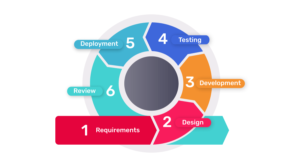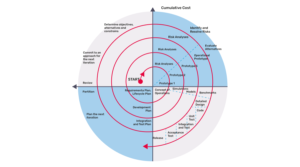
Understanding the Software Development Life Cycle (SDLC)
Nowadays, many software programs are being created to address various real-life issues, and understanding the Software Development Life Cycle (SDLC) plays a crucial role in it. It not only simplifies planning operations but also facilitates the delivery of reliable and efficient software products.
In this article, we’ll explore software development life cycle phases and controls and provide reliable examples of SDLC models, so read on!
What does SDLC stand for?
SDLC is a term that can refer to both the software development life cycle and the systems development life cycle. In this article, we are primarily focusing on the definition in relation to software development.
What is the SDLC process, and why it matters?
The software development life cycle acts as a framework that directs the entire software development process, ensuring a smooth, structured, and coordinated approach to creating high-quality software.
By adhering to the SDLC principles, developers may speed up the development process, enhance teamwork, lower errors, and ultimately deliver software that satisfies user needs.
SDLC also serves as a roadmap, providing a clear, comprehensive path from an initial feasibility study to the maintenance of the completed application.
What is a software development life cycle?
The software development life cycle comprises standardized stages a software development team must go through while creating a new product. The nature and number of phases in a software development life cycle might change based on the framework and methodology a team uses.
7 phases of software development life cycle:

Now that you know what are the SDLC phases, let’s look at each of the stages in software development life cycle in more detail.
Stages in SDLC:
1. Planning
This initial phase involves understanding the user requirements as to the product features, functionalities, and expectations and documenting them. Remember, clear and thorough requirements are the basis for effective software development.
2. Analysis
During the analysis phase, developers assess the obtained requirements and look for any potential obstacles and limitations. This entails evaluating the technical feasibility, estimated costs, and resource needs and helps create a realistic development plan.
3. Design
The main goal of this stage is the development of the software’s architecture, including designing the user interface, data flow, and overall structure. Scalability, maintainability, and performance must all be taken into account during this phase.
4. Development
In the development stage of the software development product life cycle, developers use the design specifications to write code and conduct thorough testing to fix bugs and other issues. This involves using programming languages and frameworks (e.g., Python, C++, C).
5. Testing
The testing phase help makes sure the software works as intended and complies with the initial requirements. The software’s functionality, dependability, and usability are validated using various testing approaches, including integration testing, unit testing, and user acceptance testing.
6. Integration
After the software has undergone extensive testing and received approval, it is deployed to the production environment. This entails making the product accessible to users and facilitates a seamless transition from planning to production.
7. Maintenance
In the maintenance phase, the software is regularly supported and updated to add new features, fix bugs and other issues, which helps to keep it optimized, secure, and in line with changing user requirements.
What are the types of SDLC?
There are different software development life cycle models that are followed during the product development phase. These models are called ‘Software Development Process Models.’ Each of these models includes a series of steps that are specific to its type to ensure successful product implementation.
Here are some of the most reliable examples of software development life cycle models:
1. Waterfall Model

The Waterfall model is a universally accepted model of the software development life cycle. This model divides the process into various phases that flow slowly downward, like a waterfall, through the planning, analysis, design, and development to testing and other stages of SDLC. All activities are usually ordered linearly, and developers are not allowed to skip phases.
The Waterfall model has the substantial benefit of allowing each phase to be extensively assessed for continuity and feasibility before proceeding to the next one. However, if something goes wrong during a specific phase, it may significantly slow down the process of going forward.
This model best suits projects with well-defined requirements and a clear problem understanding.
2. Agile Model

The Agile model is designed with the client in mind and places a high emphasis on user experience and input. In this model, feedback analysis is an integral element of the process as it helps create much more user-friendly software.
This model also promotes rapid delivery of software cycles in response to a constantly changing market and is well-suited for projects with rapidly changing requirements or uncertainty. The only disadvantage of the Agile model is that it relies solely on client feedback, which might cause a project to deviate from its original course or take a longer time to deploy.
3. Prototyping Model

In the case of the Prototyping model, the software is developed as prototypes or incomplete sample versions, which helps developers test the process precisely and visualize all critical components. This model typically takes a long time and delays deployment.
Even though it might result in an unsatisfied client, creating a prototype might prove useful if the software warrants it.
4. Spiral Model

The Spiral model combines the elements of both the Waterfall and Agile models and is the most flexible of the SDLC models. It incorporates multiple spirals of development and typically involves the planning, designing, coding, and testing phases after each stage of the process. Each spiral builds upon the previous one, adds new functionality, and addresses risks.
This type of SDLC is best suited for projects with a high degree of uncertainty or risk.
5. Big Bang Model

In contrast to other models of SDLC, the Big Bang model necessitates little to no planning and is effective for developers and stakeholders faced with a vague list of requirements and an unclear release date. It focuses mainly on coding practices and software development resources, enabling developers to understand and implement the requirements on the go.
This model has proven to be useful when fulfilling smaller projects or deploying software development projects for academic institutions.
Each model has its own strengths and weaknesses, and the choice will significantly depend on the project requirements. Some companies might employ a hybrid strategy with components from various SDLC models to best meet their needs.
Final word
SDLC is a resourceful, multistage process used to lay the framework for project development. It enables breaking up the project lifecycle into specific phases. The SDLC controls decision-making and offers a pretty high speed of development process that meets and even exceeds business expectations. However, its benefits in software development can only be realized if developers understand the requirements at hand and strictly follow the steps of the software development life cycle, as well as the documented plan.
If you’re not sure where to start in the software development process, don’t rely on amateurs. Hire a team of dedicated, experienced, and trusted developers with in-depth, industry-specific experience to make sure that your unique project is completed promptly. Our hand-selected experts in C, C++, Python, and other programming languages know all the ins and outs of all software development life cycle processes. They will gladly develop a successful custom software solution for your specific needs and niche anytime, 24/7!





